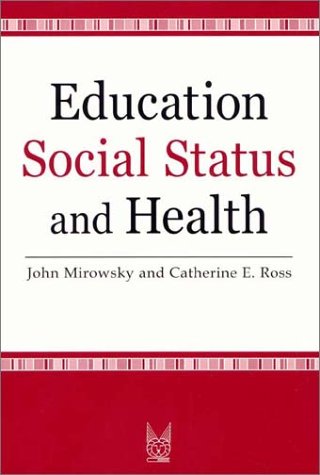Education, Social Status and Health
John Mirowsky and Catherine E. Ross
Aldine de Gruyter: New York
2003
0202307077 (pb)
£24.50
vii + 242
 Mirowsky and Ross's work ostensibly analyses the 1995 'Aging, Status, and Sense of Control' US national telephone survey (and its 1998 follow-up, as well as some other survey sources). However, the book is most noticeable for its compelling arguments concerning the mechanisms through which education influences health in the contemporary US. The authors' view is that gradations of educational experience stand out as strong and consistent correlates to measures of health; moreover, that education constitutes the single most important social influence upon health.
Mirowsky and Ross's work ostensibly analyses the 1995 'Aging, Status, and Sense of Control' US national telephone survey (and its 1998 follow-up, as well as some other survey sources). However, the book is most noticeable for its compelling arguments concerning the mechanisms through which education influences health in the contemporary US. The authors' view is that gradations of educational experience stand out as strong and consistent correlates to measures of health; moreover, that education constitutes the single most important social influence upon health.
The book has three preliminary chapters - an introduction which acts as executive summary; a dogmatic chapter 1 which outlines the main argument (that education gives individuals the preferences, abilities and resources to choose and maintain healthy lifestyles and experiences); and a background chapter containing numerous illustrations of the strong association between educational and health measures. In the core of the book, four chapters explore the multivariate mechanisms through which education apparently enhances health. Mirowsky and Ross highlight how greater educational experiences relates to a greater sense of personal control and healthy lifestyle choices (chp.3); how education acts as the pre-eminent element of social status advantage in nearly all connections between social status and health (chp.4); and how educational advantage is strongly associated with advantageous experiences of interpersonal and social relationships, with subsequent health benefits (chp.5). Perhaps the most consequential chapter is the sixth, where they anticipate the growing influence of educational effects on health over time, due to the inherently 'accumulating' and 'amplifying' nature of the relevant social processes. Chapter Seven is enjoyably provocative, dismissing 'specious views of education' popular in other literatures, and chapter 8 reiterates the pre-eminence of the role of education in anticipating health differences, with a general statement that higher levels of education are desirable for society.
The text is well presented and thoroughly convincing. Most of the new evidence comes in the form of attractive graphs showing clear trends linking health with education from the survey data. These typically involve three or four variables - measures of education and health, with additional controls for one or two further concepts. A reservation may be that these analyses are not sufficiently multivariate to appreciate the full context of the determinants of health (more complex statistical models might have helped address this). However, the convincing graphs are supplemented with extensive textual explications of the processes involved (rich in corroborating references drawn from several research fields), along with occasional examples of multivariate structural equation regression models. The combined effect is of an outstanding contribution to understanding of the processes connecting educational and health experiences.
A surprising shortcoming in this book is the absence of extended discussion of the variables analysed. In particular, measures of education - always problematic in national level cross-cohort survey investigations - receive only cursory methodological attention, almost all analyses using a simplistic categorisation which concentrates on 'elementary' versus 'high school' versus 'college'. Moreover, most other analytic concepts fare little better for formal construct theorisation. Whilst it is preferable to present falsifiable evidence and conclusions on whatever data is available - rather than the screeds of methodological procrastinations which could overwhelm this topic - it is surely desirable to strike a more even balance. Indeed, one unfortunate outcome is that the authors fail to convince the reader that their findings work at more than a descriptive level for the current setting. For instance, many readers will be interested in the social policy implications of the research. Can governments of the future simply increase educational durations in order to reap health benefits? And which influences more generally determine individual's educational experiences, and can they be altered? The authors do pay some (but not enough) attention to such questions, but a lack of depth to their conceptualisation of educational and other variables makes some of their relevant arguments unconvincing.
Mirowsky and Ross communicate strong feelings about their results, and through tactics such as their blistering attacks on the 'ideological projects and counter projects' dominant in sociological approaches to the topic (ch.7), they are surely destined to provoke irritated critique and counterclaim. The problem is that strong stances will be subjected to strong critiques. Whilst this book is an excellent example of evidence-based scientific advocacy, it seems unfortunately likely that by omitting a satisfactory discussion of variable operationalisations, the authors will have given many readers an opportunity to disregard their text.
Paul S. Lambert
Stirling University

